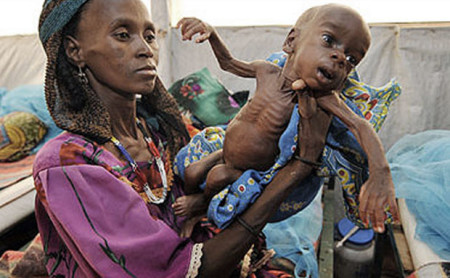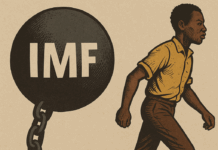Save the Children has warned that time is running out for the international community to save thousands of people from starvation in Ethiopia, as the Horn of Africa nation suffers its worst drought since the 1960s.
The two-year-long drought, worsened by the El-Nino weather pattern, has destroyed crops and livestock in Ethiopia and Somalia. Rights activist, Joachim Rahmann, of Save the Children describes the situation as “already at a magnitude where ten million people are directly dependent on food aid.
“It is not only in Ethiopia, a similar situation is unfolding in the northern regions of Somalia. Right now, we face one of the largest food insecurity crises that the region has experienced for over 50 years. What we observe is that the situation will likely get worse over the next half a year.
“Some regions have already been without rain for over two years. And until the next major rainfalls are expected in summer, the number of people directly dependent on food aid will actually increase and we are at ten million right now already.
Deutsche Welle asked Mr Rahmann about the most vulnerable of the victims, to which he responded: “Children are absolutely the most vulnerable and it is not just the situation of food aid that makes the situation for children so bad. Children are already suffering from what we call severe acute malnutrition. 400,000 children are affected by that. But the situation also bears further risks for child protection. People are leaving their regions where there used to be pasture, children are not being sent to school anymore because of the severe malnutrition – they simply cannot focus.
“Some schools have already closed. We expect that 2.5 million children will drop out of school. This is a crisis of food insecurity that is also a much larger humanitarian crisis for children.
“Compared to the famines in the past, this is a famine of huge magnitude. It is probably the biggest in the past 50 years simply when we look at the environmental dimension of the famine. But when we look now, the political systems are in place, this is a different situation than we have experienced in the past.
“Over the last decade, Ethiopia has made huge economic gains. Child mortality has been reduced by two thirds. There were systems in place and there still are systems in place from the Ethiopian side to tackle food insecurity. There are regularly around eight million people in cash for work programs to address people’s food insecurity needs during the lean season. But the situation is so huge that the Ethiopian government cannot cope with it by itself. The Ethiopian government has already committed around 370 million dollars (330 million euros) to the crisis.
“The country is living up to the expectations. But the crisis is so large that the international community has to step in and it would be unforgivable in a situation where the magnitude is large and where the government itself is already living up to it, where the systems are in place, where people can be reached, to not get assistance from the international community.
“From the situation where we are right now, we can say that organizations like Save the Children are already present on the ground, they are supplying direct food aid, and they are addressing children’s child protection needs. But the international appeal of which Save the Children is part of goes up to 1.4 billion. This is the scale of the crisis we are talking about.
“And if we compare it internationally, Save the Children only labels two crises right now as category one which is the Syria crisis and the Ethiopia crisis. But for the Ethiopia crisis only half of the funds needed to address the most immediate needs have been committed. And we only have a time window of three weeks to commit these funds to not risk people dying.
“If the time window is not met, the food supply chain cannot be maintained. It takes time to procure food in the magnitude that is needed to supply to people, when ten million people are already food insecure. It is the size of the population of some European countries! And that is in direct need of food aid. That takes time. The next rains are only expected in summer. So the next three weeks are crucial to live up to these expectations.”










